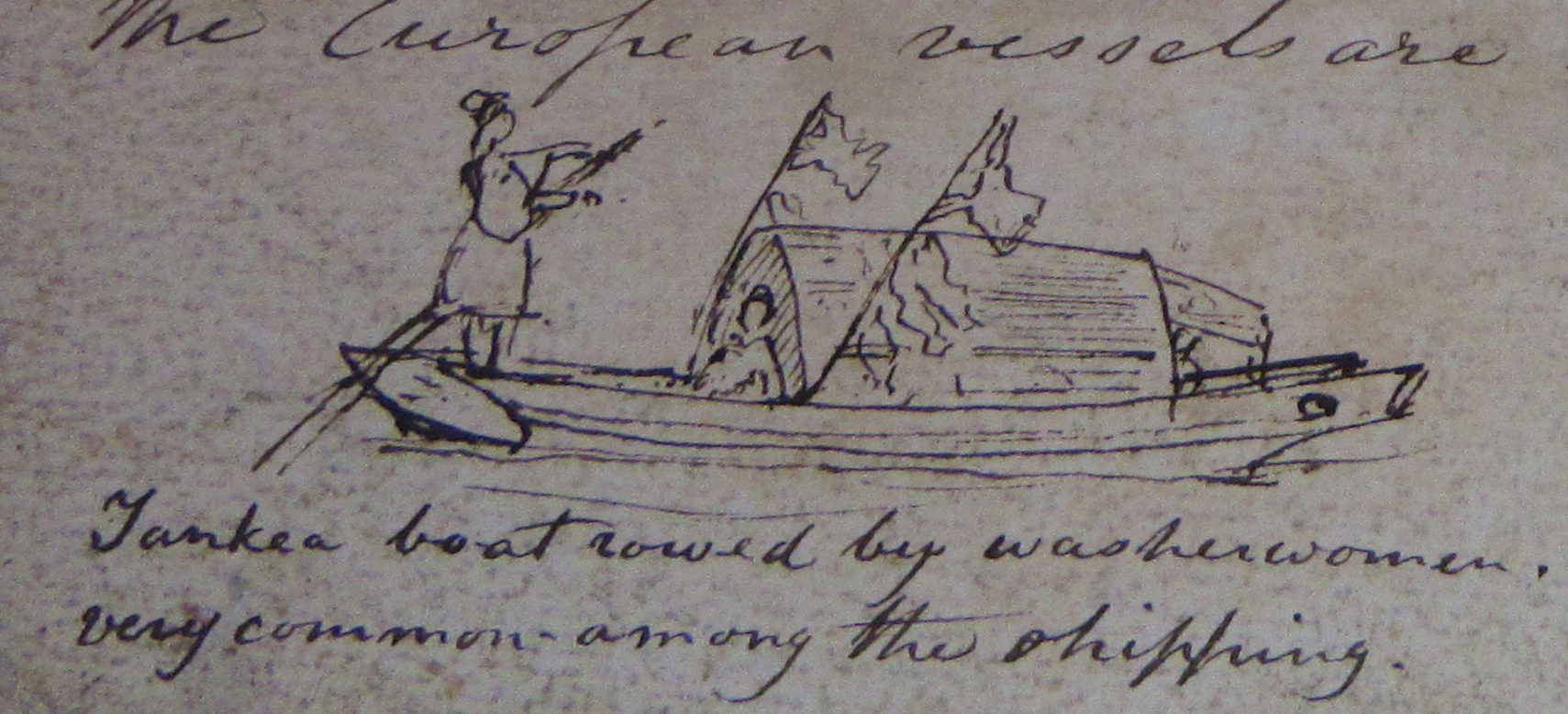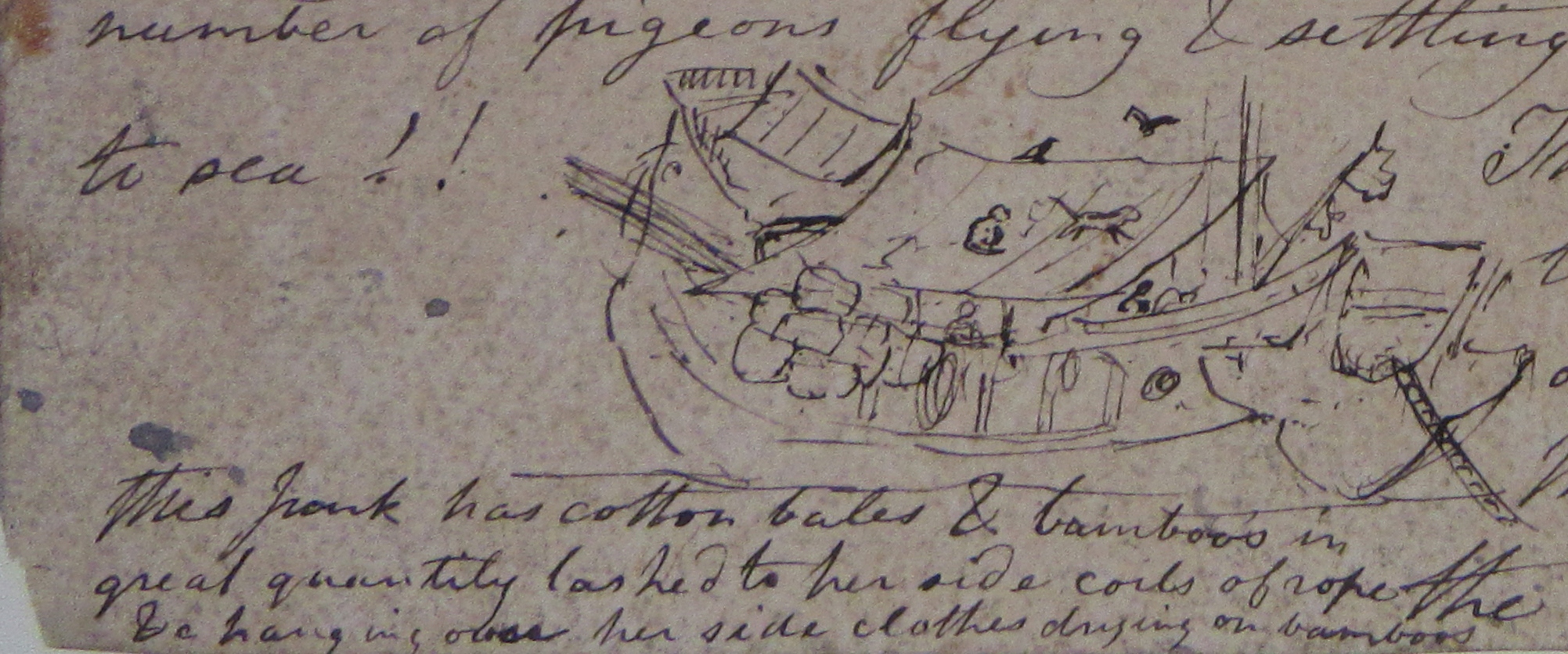
Let’s continue with Lt. Warre’s panoramic view of the Huangpo River. As we move to panel three the scene starts to become quite a bit more crowded. Lt. Warre states that the mass of junks and European shipping is so thick at this point that it pretty much fills the river from bank to bank. Of course, he is still lamenting that his paper isn’t wide enough and he also states that he hasn’t been able to represent the river traffic nearly as densely as he wishes “So far from the number of vessels being exaggerated they are not half thick enough!”.
At this point Warre gives a quick description of the right bank of the river (which we can’t see). He states: “Behind the shipping is the Chinese City of Shanghae, a large walled city, but the houses all low and mean and not visible above the city walls, except on the river side.” The mass of shipping on the left bank of the river extends two or three miles and Warre states that to be accurate even the foreground of the scene should be completely filled with boats. I am glad he didn’t completely fill the scene because it would make it really difficult to see the particular details he has included.

At the center left of panel Warre shows an opium clipper (brig) anchoring (I tried to interpret the four flags hoping to identify the vessel but unfortunately they don’t correspond to Marryat’s signaling system). Warre depicts European vessels laying among the “tiers of junks”. Besides the British you can clearly see American and Spanish flagged vessels. At this point Warre gets a little more specific about the shipping we would see: “A great number of ferry boats filled as thick as they can stow with coolies are constantly crossing from one side to the other.” I talked to Lyles about exactly what “coolies” refers to and he said that this is essentially the Chinese version of a longshoreman. If you’ve seen any old movies then you’d recognize them as they always wear a cone shaped woven hat.
Warre also states that another common boat seen among the shipping is the “Tankae” boat which was rowed by washerwomen. He obviously thinks it’s important because he provides us with another one of his wonderful supplementary sketches. It is a total hoot because hanging off tall poles is drying laundry! The boat depicted (according to Aak to Zumbra) is a sampan Tanka which is a general purpose harbor craft that are principally crewed by women.

HMS Scout (14 guns), Warre’s vessel, is depicted at anchor in the middle of the river and behind it is the European quarter. At the extreme left (behind the black hulled barque with the Dutch looking flag flying from the main mast) you can see a yellow flag hoisted behind the topsail spars of the vessel. The flag is flying above the Chinese custom house and marks the start of the area where the English are allowed to purchase and build. At this point Warre states that technically “no other fanqui’s” (which means foreigners) are allowed to build there but “this of course is evaded, the foreigner’s holding as third parties.”

He describes the area thusly: “The English have already made a sea wall of timber &c opposite their houses with commodious wharves. They have a bamboo paling to keep of the populace who loiter about there in crowds.”
The Singapore junk at anchor on the right of the picture apparently isn’t depicted as large as it should be. According to Warre the vessel should be “twice as large and great deal more slovenly (!)” with “cats and dogs running about a large sloping mat awning, and a number of pigeons flying and settling about her for the Chinese take a farm to sea!!” To emphasize just how “slovenly” and animal infested Warre makes a sketch on the reverse showing the junk with “cotton bales and bamboos in great quantity lashed to her side coils of rope &c hanging over her side clothes drying on bamboos.” He also shows cats and dogs and birds all over the vessel.

I did learn today that Shanghai wasn’t open to Europeans until 1842 which means Warre’s 1846-1847 panorama really shows the early stages of Shanghai as a treaty port. It’s really amazing how quickly the area was developed. Among the buildings Warre shows are a “large house with green verandas” which belonged to Turner & Co. and a buildings that belong to Messrs. Dent Beale and Co. (originally opium dealers who later traded in tea and silk) with godown’s (which are storehouses) and offices adjacent.